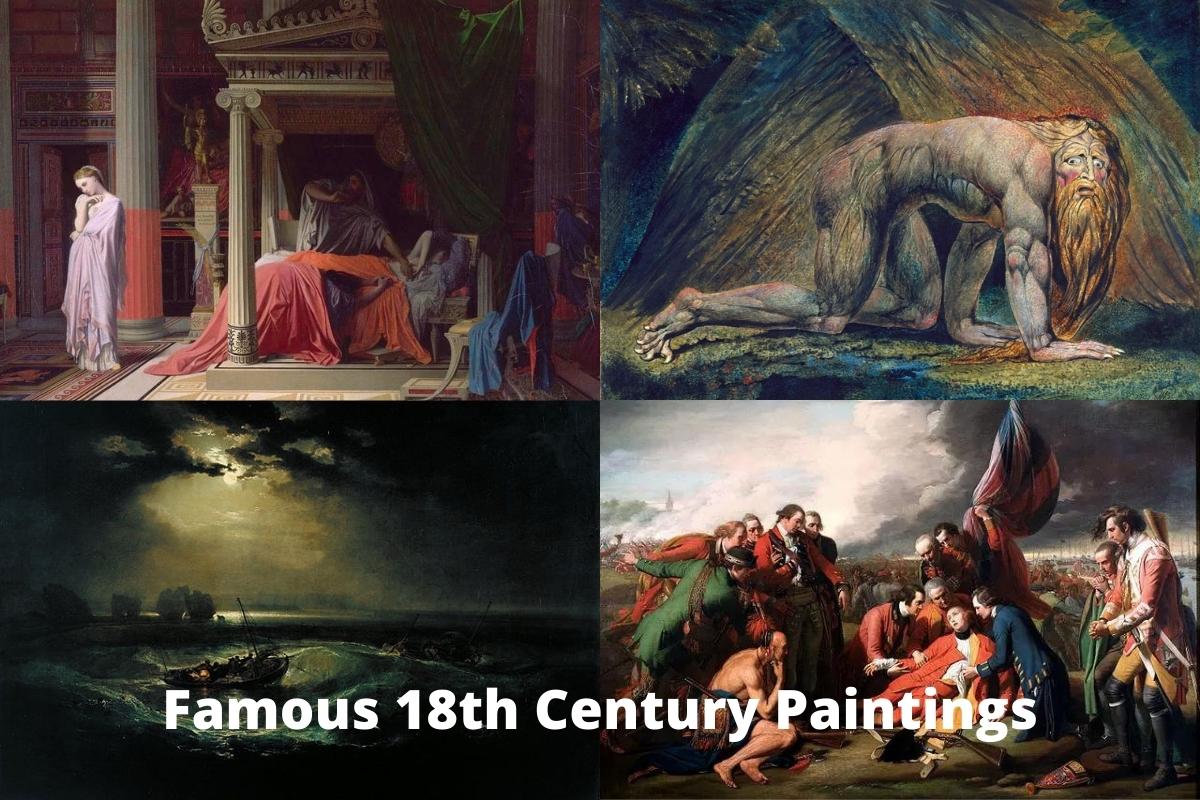The French Revolution and the Age of Enlightenment both had a profound impact on the artistic landscape of the 18th century.
Both of these occurrences significantly impacted the art world.
Much of 18th-century painting can be categorized under the Rococo and Neoclassicism periods, with the former representing a continuation of the Baroque style and the latter being in direct opposition to it.
Artists like Turner and Constable, both born in the 18th century, are often considered to be among the best landscape painters in history.
Famous 18th Century Paintings
1. The Death of Marat – Jacques-Louis David
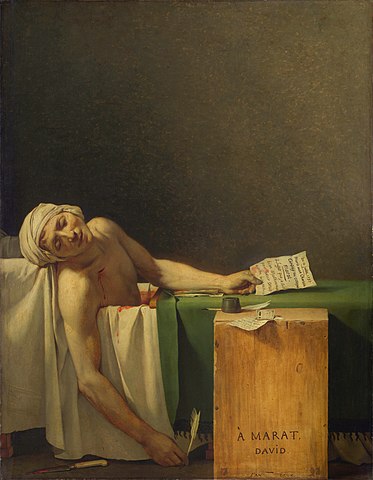
In the late 1700s, the French Revolution was underway, and Jean-Paul Marat was one of the most prominent personalities associated with its leadership.
The death of this journalist-turned-politician represented a watershed moment in the struggle to wrest control of the country from the clutches of the affluent aristocracy.
A lady who sympathized with a group Marat had been responsible for nearly eradicating stabbed him to death.
The Death of Marat is a painting by Jean-Francois David that depicts the assassination of the French revolutionary and is now widely recognized as a masterpiece of Neoclassical art.
Jacques-Louis David painted it in 1793, just a few months after Marat’s death, to honor the political figure’s life and efforts to fight for the cause that would ultimately drive the deadly revolution.
Although David was one of the most prolific artists of the Neoclassical era, many of his paintings did not deal directly with historical figures or events.
In this painting, a dying Marat is depicted in a bathtub, holding a message in his hand. The paper contains a message about his murderer, a woman named Charlotte Corday.
2. The Swing – Jean-Honoré Fragonard
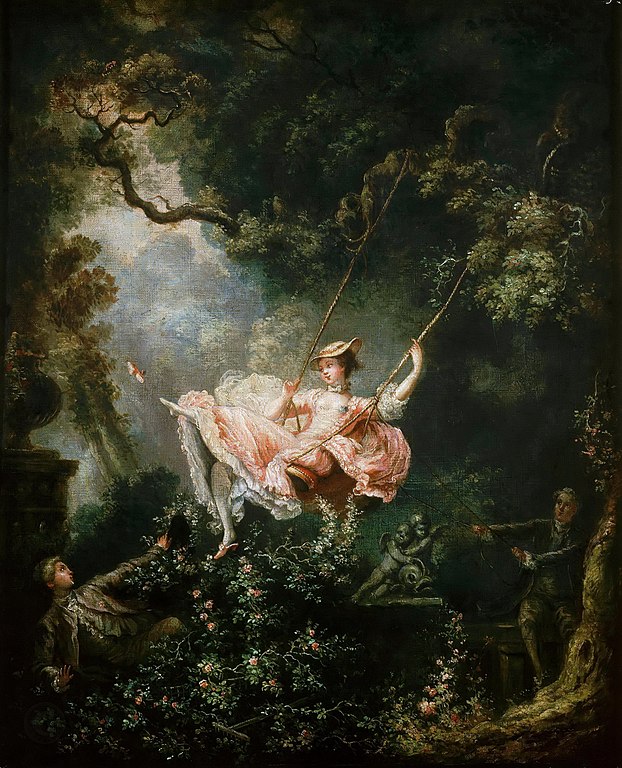
Jean-Honoré Fragonard was well recognized as a leading Rococo artist. Throughout his long and successful career, which spanned the second half of the 18th century and the Rococo period
He created countless masterpieces for the French royal family, The Swing, painted in 1767, is his most famous piece.
In this piece, a young man watches from the bushes below a young woman as she swings joyously on a tree branch.
The man’s perspective is such that he can see the young woman’s clothing from beneath it, alluding to the hedonistic mood that permeates many of Fragonard’s works. Behind the woman, in the darkness, another man can be seen pulling the swing with a set of ropes.
During Fragonard’s lifetime, this piece caused some consternation since it was seen as overly frivolous for 18th-century French society.
3. The Death of General Wolfe – Benjamin West
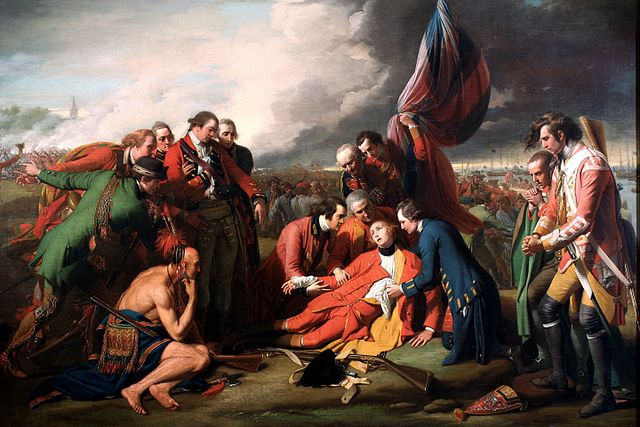
The French and British fought bloodily and relentlessly for control of the colonies that were then under French rule during the Seven Years’ War.
The Battle of Quebec, which took place in 1759, is widely considered to be one of the war’s most pivotal engagements. The Battle of Quebec barely lasted 15 minutes, yet it was a fierce conflict that ultimately led to the death of British General James Wolfe.
Benjamin West painted a scene from the battle titled “Death of General Wolfe” to remember the event. Although this painting, completed in 1770, is widely recognized as a masterpiece of Neoclassical art, it is historically wrong in several key respects.
Wolfe is seen in the painting dying in the arms of his officers, but he was actually shot dead by French forces.
4. Isaac Newton – William Blake
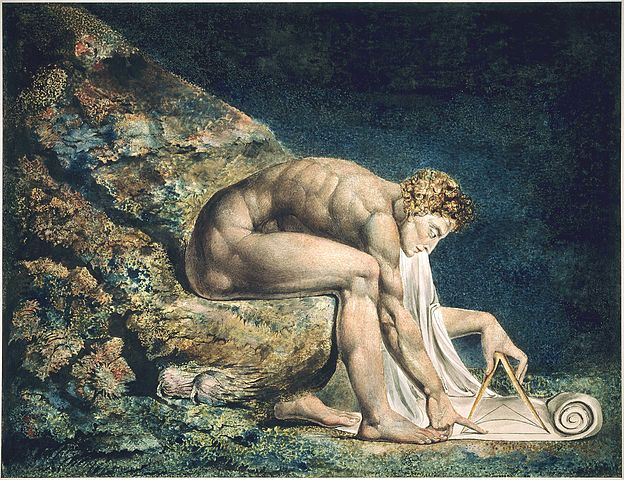
William Blake immortalized the esteemed scientist and meteorologist of the 17th and 18th centuries in a masterpiece.
Isaac Newton is a picture by William Blake, who depicts the famous scientist as a young, ripped man relaxing on a boulder. Newton is typically shown by artists as a stodgy old philosopher, deep in meditation, but this image is a departure from that.
Reportedly strongly critical of Newton’s attitude to science, Blake depicted the famed theologian and physicist as intent on a small piece of parchment underneath with geometric symbols inscribed on it, and oblivious to the beauty surrounding him.
5. Fishermen at Sea – J.M.W. Turner
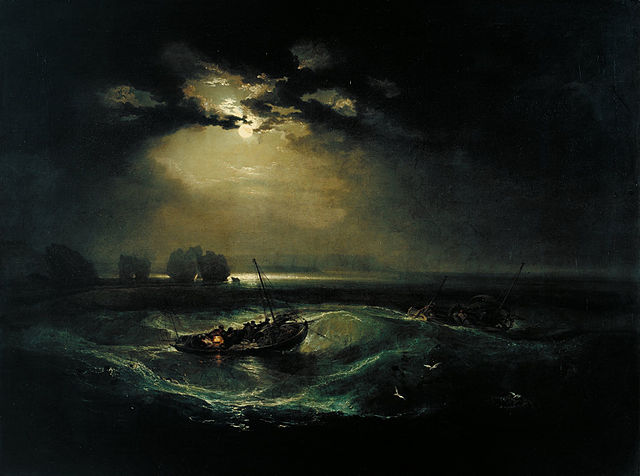
The Cholmeley Sea Piece, also known as Fishermen at Sea, is an early oil painting by J. M. W. Turner. The Tate Gallery has had it in their possession since 1972, while it was first exhibited at the Royal Academy in 1796.
The dimensions of the artwork are 36 x 48.125 inches (91.44 x 122.24 centimeters).
This picture was Turner’s debut at the Royal Academy. The critical reception it received in its day helped cement Turner’s status as a master of oil painting and a pioneer in the genre of maritime art.
Moonlight illuminates the scene of fishermen braving rough seas near the Needles on the Isle of Wight.
The tiny boat and its dim lamp represent the frailty of human life, while the vast sea and foreboding rocks in the background represent the overwhelming strength of nature.
The cold brightness of the Moon at night is in stark contrast to the cozy light of the fisherman’s lantern.
6. The Triumph of Venus – François Boucher
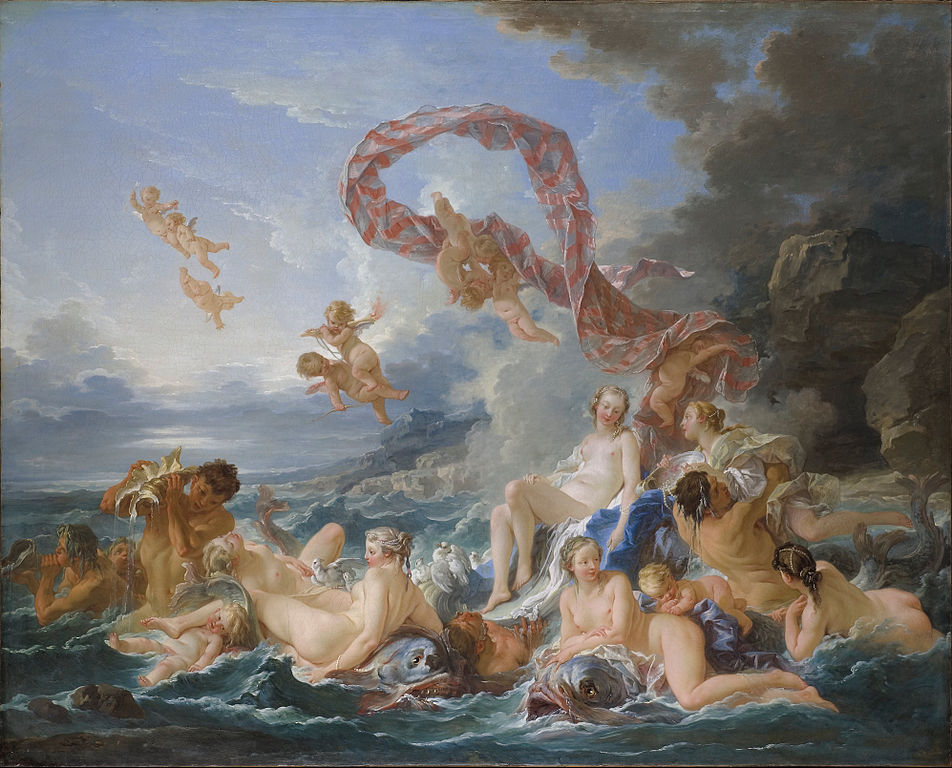
Perhaps the most well-known figure from the Rococo period is François Boucher. It was his painting style, which frequently included mythological creatures or locations, that would ultimately revolutionize French art during his lifetime.
His method stood out since most of his works featured gorgeous women in natural settings.
Although Boucher is responsible for a number of highly regarded Rococo paintings, the most renowned of these is perhaps his Triumph of Venus.
This picture from 1740 depicts the goddess Venus immediately after her birth from the ocean. She is surrounded by the usual assortment of nymphs, cherubs, and tritons seen in Rococo artwork.
The picture is a prime example of the asymmetrical style characteristic of Rococo art, and it popularized the inclusion of legendary figures in subsequent works by other 18th century artists.
7. Ancient Rome – Giovanni Paolo Panini
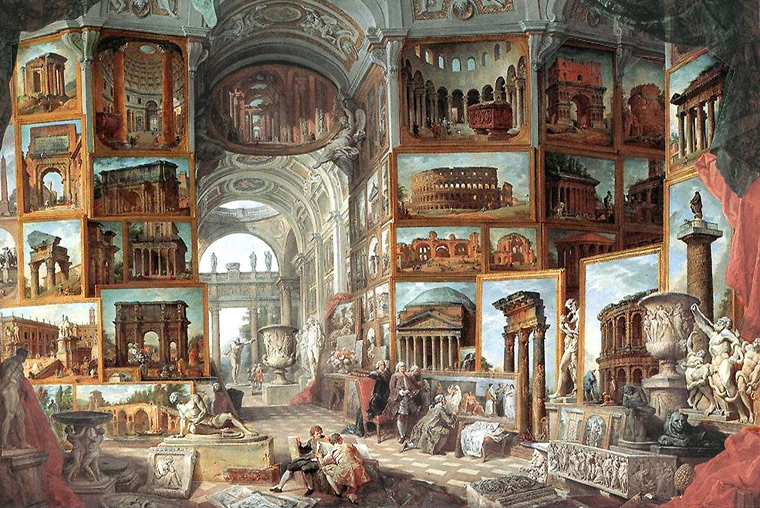
Italian painter and architect Giovanni Paolo Panini lived in the 16th and 17th centuries. Primarily, he is remembered as a “view painter” (vedutisti) who portrayed Roman landscapes.
Panini, who was born on June 17th, 1691, spent most of his life and career in Rome, where he was inspired by the city’s old ruins.
The inside of the Pantheon and galleries depicting Rome are two of his most well-known works. He frequently depicted Roman ruins with capriccio flourishes reminiscent of Marco Ricci’s work.
The fields of perspective and optics were taught in Panini’s classrooms. His work at the French Academy in Rome, where he taught, advanced the state of the art in panoramic art.
In addition to his many pictures of famous people like Pope Benedict XIV, he is best known for his masterful use of perspective.
Several different royal families sought him out to adorn their palaces, as they really admired his work. On October 21, 1765, in Rome, Panini passed away.
8. Oath of the Horatii – Jacques-Louis David
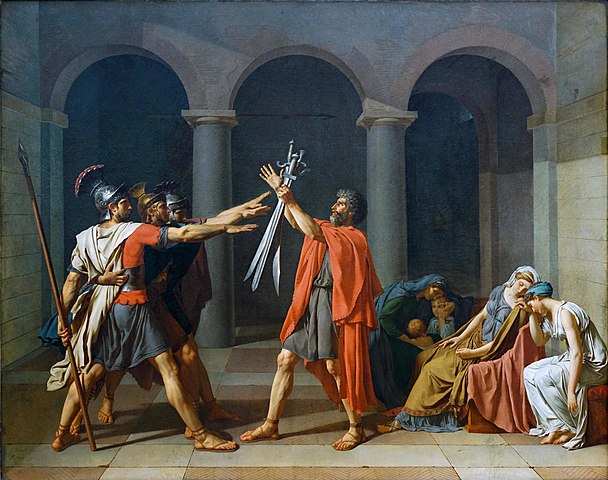
Early in his career, Jacques-Louis David focused primarily on depicting the most important historical figures and events from the Classical period.
In the early 1780s, he was a student at the French Academy in Rome, where he became enamored with some of the most well-known characters and legends of ancient Rome.
During this time, in 1784, he painted what is widely considered to be David’s magnum opus by art historians and critics.
The piece, named Oath of the Horatii, is notable for its use of Neoclassical characteristics such as vivid colors and a focus on historical authenticity in depicting what was thought to be the true story at the time.
The painting is based on a myth from the 7th century B.C. which details an argument between two municipalities.
The tale goes that the three brothers of the Horatii family fought the three brothers of the enemy city. The lone remaining Horatii sibling was able to vanquish their three attackers.
As they prepare to go into war, the Horatii brothers greet their father, who is holding their swords.
9. The Meeting (from the Loves of the Shepherds) – Jean-Honoré Fragonard
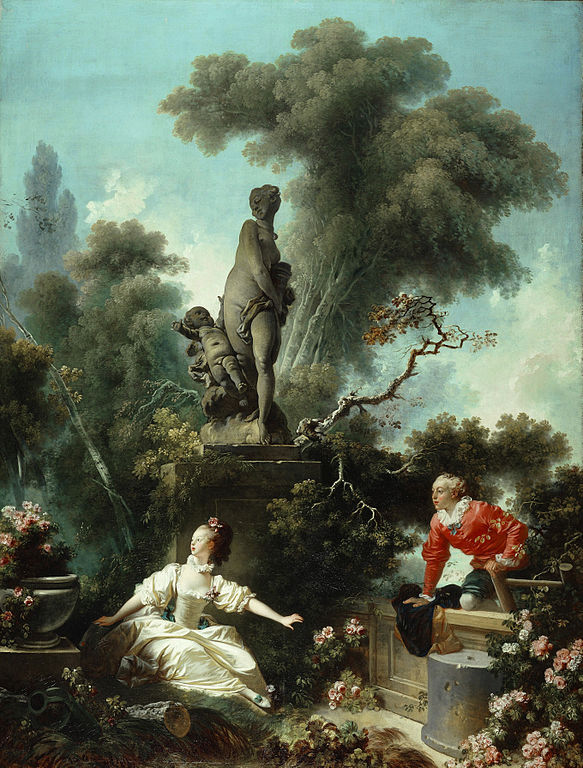
Rococo painter Jean-Honoré Fragonard is well known for his lighthearted, hedonistic scenes.
He frequently depicted young couples in intimate settings, even though doing so was frowned upon by conventional French society. That’s how his signature piece, The Meeting, ended up (from the Loves of the Shepherds).
This picture dates back to 1772, and it depicts a young man and woman who are obviously having a rendezvous that they want to keep secret.
The man can be seen scrambling over the wall, while the young lady can be seen looking over her shoulder as if making sure no one is watching their party.
10. Cornelia, Mother of the Gracchi, Pointing to her Children as Her Treasures – Angelica Kauffman
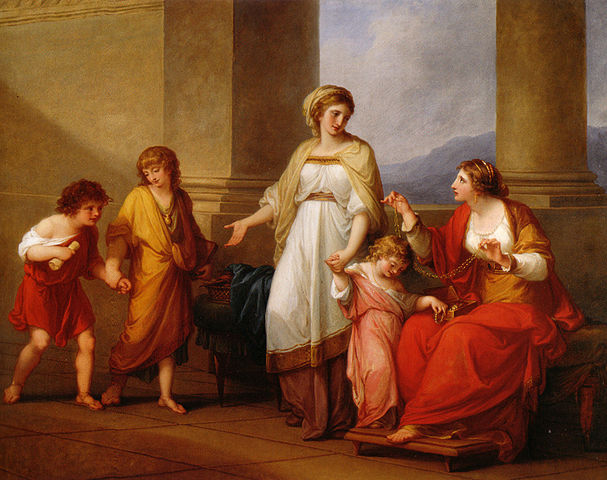
Angelica Kauffman was a prominent Swiss Neoclassical painter. She spent several years in Austria, where she painted a wide variety of historical personalities.
A painting she completed in 1785 is universally recognized as a masterpiece of the artist’s oeuvre and Neoclassical art.
Cornelia, Mother of the Gracchi, Holding Up Her Treasures, Her Children is the title of the artwork. Cornelia is depicted; she is thought to have been the mother of prominent Roman figures Tiberius and Gaius Gracchus.
Legend has it that Cornelia encountered a woman who proudly displayed the wealth she had amassed in the form of jewelry and other valuables. Cornelia pointed to her children, the future rulers of Rome, when the woman asked to view her most valued possessions.

